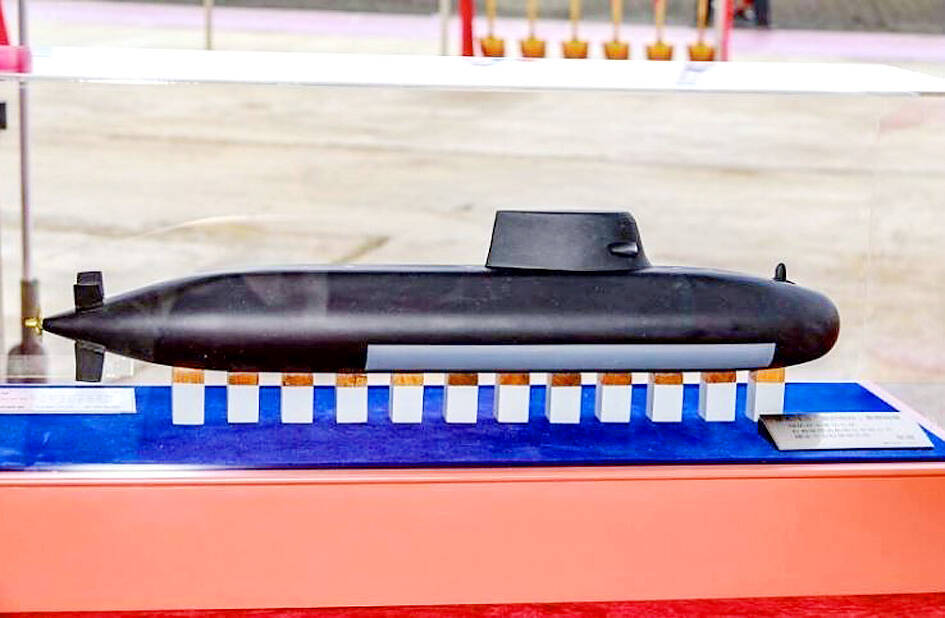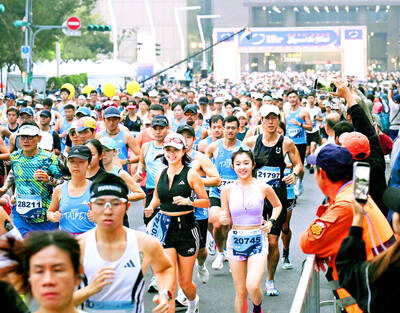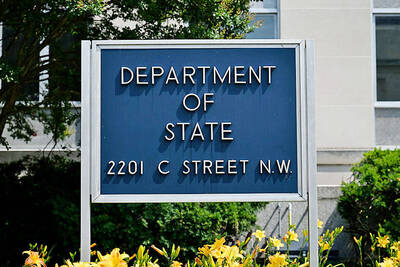Taiwan hopes to deploy at least two new, domestically developed submarines by 2027, and possibly equip later models with missiles to bolster its deterrence against the Chinese navy and protect key supply lines, the head of the program said.
Taiwan has made the Indigenous Submarine Program a key part of an ambitious project to modernize its armed forces as Beijing stages almost daily military exercises.
President Tsai Ing-wen (蔡英文), who initiated the program when she took office in 2016, is expected to launch the first of eight new submarines on Thursday under a plan that has drawn on expertise and technology from several nations — a breakthrough for diplomatically isolated Taiwan.

Photo courtesy of the Ministry of National Defense
Admiral Huang Shu-kuang (黃曙光), head of the nation’s Indigenous Defense Submarine program, said that a fleet of 10 submarines — which includes two Dutch-made submarines commissioned in the 1980s — would make it harder for the Chinese navy to project its power into the Pacific.
“If we can build up this combat capacity, I don’t think we will lose a war,” Huang this month told an internal briefing on the project, which was attended by Reuters.
Huang said the first submarine, with a price tag of NT$49.36 billion (US$1.54 billion), would use a combat system by Lockheed Martin Corp and carry US-made MK-48 heavyweight torpedoes. It is to enter sea trials next month before being delivered to the navy by the end of next year.
For subsequent models, Taiwan would leave space for submarine-launched anti-ship missiles, but adding those weapons depends on production availability in the US, where capacity is already tight, Huang said, without naming the companies that would be involved.
He called the submarines a “strategic deterrent” to Chinese warships crossing the Miyako Strait near southwestern Japan or the Bashi Channel that separates Taiwan from the Philippines.
Taiwan’s diesel-electric submarines can keep China at bay within the first island chain, Huang said, referring to the area that runs from Japan through Taiwan, the Philippines and on to Borneo, enclosing China’s coastal seas.
“This was also the strategic concept of the US military — to contain them within the first island chain and deny their access,” he said. “If Taiwan is taken, Japan will definitely not be safe, South Korea will definitely not be safe.”
The Chinese Ministry of National Defense did not respond to a request for comment.
The Chinese navy, including its Shandong aircraft carrier, has become increasingly active in the past few months off Taiwan’s eastern coast, prompting worries that Beijing could launch an attack from that direction. Eastern Taiwan is where planners have long envisioned the military regrouping and preserving its forces during a conflict.
The submarines can help maintain Taiwan’s “lifeline” to the Pacific by keeping ports along its eastern coast open for supplies in a conflict, Huang said.
“The submarines will keep their ships away from our eastern shores,” he said.
Chieh Chung (揭仲), a military researcher at the National Policy Foundation think tank, said the fleet would have trouble with that task, because China could position warships in the Pacific before launching an attack.
However, he added that the submarines could occupy strategic ambush points in the region and “greatly harm [China’s] combat ability” by targeting high-value ships such as carrier groups or landing fleets.
Taiwan has quietly sourced technology, components and talent from at least seven nations to help it build submarines, a Reuters investigation has found.
Getting foreign assistance was particularly challenging for Taiwan, which does not have official ties with most nations.
Huang declined to say which nations had approved export permits, but said he had reached out to generals from nations that included the US, Japan, South Korea and India.
“For those foreign generals who agreed with my ideas, they helped convey the message to their governments or arrange meetings,” he said. “I told them our needs and that’s how we achieved our purpose of securing export permits.”
Huang also expressed thanks for “great help” from a team led by an unnamed retired rear admiral of Britain’s Royal Navy, who secured export permits from the UK through a Gibraltar-based company.
Britain sharply increased the amount of submarine parts and technology exports approved for Taiwan last year, a Reuters analysis of the data showed.
Huang described the program as “even harder than reaching the sky,” citing challenges such as a global chip shortage that hit many manufacturers around the world.
He said his team scrambled to source chips from Taiwan to avoid delays by foreign vendors.
A foreign supplier had also pulled out at the last minute after the work with Taiwan was leaked to a Chinese embassy, he said, without elaborating.
China’s frequent military harassment, including close approaches to Taiwan’s territorial waters and airspace, has prompted Taiwan and the US to rethink the nation’s “asymmetrical” strategy of making its forces more mobile and harder to attack, with a focus on smaller weapons systems, he said.
“The American thinking is changing gradually. They realized that you can’t withstand [the harassment] without bigger boats,” Huang said, pointing to the navy’s plan to build a new generation of bigger frigates.
“They are getting closer and closer,” he said, referring to China.

A car bomb killed a senior Russian general in southern Moscow yesterday morning, the latest high-profile army figure to be blown up in a blast that came just hours after Russian and Ukrainian delegates held separate talks in Miami on a plan to end the war. Kyiv has not commented on the incident, but Russian investigators said they were probing whether the blast was “linked” to “Ukrainian special forces.” The attack was similar to other assassinations of generals and pro-war figures that have either been claimed, or are widely believed to have been orchestrated, by Ukraine. Russian Lieutenant General Fanil Sarvarov, 56, head

SAFETY FIRST: Double the number of police were deployed at the Taipei Marathon, while other cities released plans to bolster public event safety Authorities across Taiwan have stepped up security measures ahead of Christmas and New Year events, following a knife and smoke bomb attack in Taipei on Friday that left four people dead and 11 injured. In a bid to prevent potential copycat incidents, police deployments have been expanded for large gatherings, transport hubs, and other crowded public spaces, according to official statements from police and city authorities. Taipei Mayor Chiang Wan-an (蔣萬安) said the city has “comprehensively raised security readiness” in crowded areas, increased police deployments with armed officers, and intensified patrols during weekends and nighttime hours. For large-scale events, security checkpoints and explosives

PUBLIC SAFETY: The premier said that security would be tightened in transport hubs, while President Lai commended the public for their bravery The government is to deploy more police, including rapid response units, in crowded public areas to ensure a swift response to any threats, President William Lai (賴清德) said yesterday after a knife attack killed three people and injured 11 in Taipei the previous day. Lai made the remarks following a briefing by the National Police Agency on the progress of the investigation, saying that the attack underscored the importance of cooperation in public security between the central and local governments. The attack unfolded in the early evening on Friday around Taipei Main Station’s M7 exit and later near the Taipei MRT’s Zhongshan

REBUFFED: In response to Chinese criticism over recent arms sales, Washington urged Beijing to engage in meaningful dialogue instead of threats and intimidation Washington’s long-term commitment to Taiwan would not change, the US Department of State said yesterday, urging Beijing to stop pressuring Taiwan and engage in meaningful bilateral dialogues. The remarks came in response to a backlash from Beijing about Washington’s latest approval of arms sales to Taiwan. The US Defense Security Cooperation Agency said in a statement on Wednesday that the Taipei Economic and Cultural Representative Office in the US has asked to purchase an arms package, including Tactical Mission Network Software; AH-1W helicopter spare and repair parts; M109A7 self-propelled howitzers; HIMARS long range precision strike systems; tube-launched, optically tracked, wire-guided missiles; Javelin